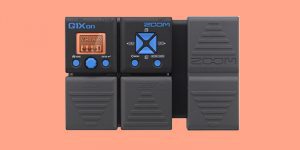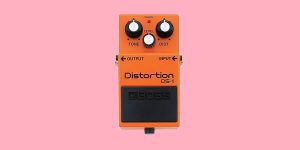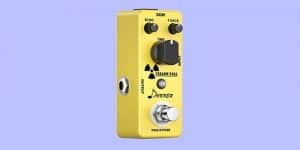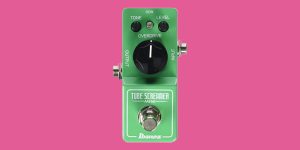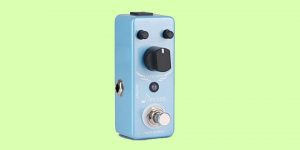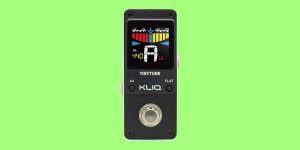The Best Guitar Effects Pedals for Beginners
If there’s one thing that I believe about learning guitar, it’s that it has to be fun. I tell people this over and over again, but a beginner is always going to do much better when they’re really having a good time playing guitar.
When a new player really has a blast every time they play, it leads directly to them playing more often. I probably don’t have to say it, but that, in turn, directly leads to them becoming better much faster than people who you have to drag to their instrument.
Guitar effects pedals are something that you don’t need to play guitar, but for a lot of players, especially beginners, they make things so much more fun. For some parents, they can make the difference between dragging their kid to go and practice, to having to drag their kid away from the guitar to go to bed.
What actually are guitar effects pedals?
Effects pedals are just little electronic boxes with some knobs on them. Instead of plugging your guitar into an amplifier, you plug it into the effects pedals, and then a second cord goes from the pedal into the amp.
The effects pedal changes the sound of the guitar in some way. They might add fuzz to the sound, a pleasant echo, a funky wah-wah effect – there are dozens of possibilities (spread across thousands of different models currently being made).
Effects pedals basically just make the guitar sound better, and usually more professional.
How much do they cost?
There’s a wide price range, but generally they run from about $30 (for surprisingly great no-name brands) to $100 (for a regular pedal from one of the big names). Of course, the world being what it is, you can also buy boutique pedals for much more (including pedals that cost hundreds of dollars and still have long waiting lists), but that’s obviously not necessary for a beginner.
In fact, I’m going to start this list with a pedal with dozens of different built-in effects that costs $80 and does everything, and even includes a guitar tuner. If you’re on a budget, this is an incredible value, and it’s actually almost hard to recommend anything else for a beginner.
Can I use effects pedals with an acoustic guitar?
If you have an acoustic guitar with a pickup built-in, yes, otherwise not really. But if your guitar does have a pickup in it (and many acoustic do these days), then adding effects can be great, and produce a very satisfying sound – especially echo-like effects, like delay and reverb.
Okay, let’s get to the effects pedals:
Zoom G1Xon
The $80 Pedal That Gives You Everything.
As someone who has played guitar since 1990, and kept up to date on gear, I am blown away by the value the Zoom G1Xon gives you. I think it’s fair to say that this pedal does everything, and it’s really astounding that it can do so for less than the price of a standard pedal made by one of the big brands like BOSS or TC Electronic.
The G1Xon (not a catchy name!) contains 75 effects, as well as 14 simulated amp sounds (these alter the sound as well), and some other goodies like a looper, a tuner, drum beats and a wah-wah pedal.
This unit contains 75 effects, and they’re a very wide-ranging selection. Basically, the sounds you get in this multi-pedal are clones of popular guitar effects pedals. For the most part, they’re all eerily close to the real things, and it’s very hard to tell the difference.
The effects range from the standard distortion/fuzz effects, to an extremely wide range of time-based effects (like reverb, delay, echo), and then some really niche or wacky sounds that you might not expect. I own a Zoom G1Xon myself, and I honestly can not think of a single guitar effect that doesn’t have a version in here.
That’s not all that’s in the unit though, not by a long shot. The G1Xon also contains a number of amp simulations, so you can sound like you’re playing through all sorts of expensive amps, from vintage blues classics to modern metal machines.
It also has a built-in expression pedal. This pedal can be used to control your volume, but most people will want it to use as a wah-wah pedal. I’ve done this, and the wah sound is great, and insanely fun (as all wah pedals are, in my opinion).
Is that all? Heck no! There’s also a guitar tuner built right into the pedal, and you can activate it at any time by pressing down on both pedals at once. This is extremely useful for anyone, no matter their experience level or musical style.
There’s also a headphone jack! If you’re a parent shopping for your child, this is actually a bit of a gift to you as well. You can’t plug a guitar directly into headphones (even though the jacks look like you should be able to with an adapter) because it doesn’t send a powerful enough signal. Some, but not all, amps have headphone jacks built in, but these don’t always sound the best.
The headphone jack on the G1Xon lets you practice in peace, without the world getting in to annoy you, and without your family, or roommates, getting annoyed at the sound. Take it from me, this is a much more important, and nice, feature than it seems at first glance.
I almost forgot that this unit contains a looper and built-in rhythms that you can jam to. If you’re not familiar with loopers, check out my full review of the G1Xon.
Overall, if you’re just looking for a cheap, simple pedal that literally does everything, you can’t go wrong with the Zoom G1Xon. So why am I even writing anything else on this list? A few reasons:
For one thing, there are disadvantages to having one does-it-all multi-effects unit vs. individual pedals.
First off, if you have a bunch of individual pedals, it’s faster to change all your settings, since they will have 1 knob for every setting. On a multi-effects unit, you need to go and edit the settings on a screen, by navigating through menus using a wheel.
On top of that, having individual pedals is a more traditional approach, and guitar is still a very traditional instrument. There are tons of folks out there who idolize popular guitarists, and want to emulate their pedalboard. If you’re a massive Jack White fan, you can come very close to matching his sound using a multi-effects unit, but it just doesn’t seem right – most people want to go out and get the same pedals he uses (which also look and feel cooler to step on).
And that brings me to the last reason: Pedals are fun to collect! They don’t cost a ton, they look cool, and they can very directly help you be creative, and make your music sound better. Buying one unit that does everything is fine, but to a large amount of people, it’s just not as appealing as the hobby of pedal-collecting.
BOSS DS-1
The Cheap Distortion Everyone Has Played
The BOSS DS-1 has been around since 1978 for a reason. It’s a solid, inexpensive distortion pedal, that sounds great for a number of different styles. You can turn it way up to blast out some thrash metal, or tone it down for some crunchy blues rock.
For a brand name pedal, the price is very low, but don’t let that fool you into thinking it sounds cheap. Famous players from Prince to Steve Vai, to Kurt Cobain, to John Frusciante, have used the BOSS DS-1, and it’s surely on the pedalboards of many future guitar icons, as we speak.
The Donner Yellow Fall Delay
A Cheap Delay Pedal With Character
When you add some time-based effects to your guitar playing, it sounds more full, and professional. One of the big themes I like to repeat on Kidguitarist.com is that people will practice longer, and learn faster, when they’re enjoying themselves, and feel proud of what they’re doing. Adding a delay effect can make any guitar sound bigger, and nicer, and can be a nice investment.
The Donner Yellow Fall Delay pedal in particular is a pretty safe bet, because it sounds great, but only costs around $35.
I have one of these, and I love playing with it. It only has 3 knobs on it (Echo, Feedback and Time), so it’s easy to dial in different sounds with a minimum of fuss. This also means that the Yellow Fall isn’t as full-featured as a more complex delay pedal, so there are some effects you may not be able to achieve easily, so it depends on what you’re looking for. At this price, it doesn’t hurt too much to buy another pedal later if you decide you need more features.
Maybe the most notable thing about this pedal is that it’s an analog pedal, as opposed to digital. Both of these pedal types are just as good as each other, and there are guitarists who swear by either type, but most player don’t really care too much which they use. However, the reason that it’s particularily important on this pedal, is that the Yellow Fall has a very analog-sounding decay to its effect.
This means that if you play a note (or chord), and then listen to the echos, you’ll notice that each echo gets a tiny bit more low-fi. This might sound bad at first, but it’s actually a very desirable effect, that gives the sound a lot of warmth. The MXR Carbon Copy Analog Delay is a classic pedal that costs many times more than the Donner, and is well-loved for the same decay effect.
Ibanez Tube Screamer
The Most Iconic Overdrive Pedal in History
If you’re unfamiliar with overdrive pedals, they’re essentially effects that distort your tone, and add fuzz to it, but they don’t get as dirty as full-on distortion pedals. Overdrives are one of the most popular types of pedals, probably tied for the #1 spot with their close cousins, distortion pedals. Every guitar player I know has at least one of these, but many of them have several different “flavors” of them.
The Ibanez Tube Screamer is by far the most iconic overdrive ever. It comes in a variety of sizes and options, but they all have the same basic sound, which is a great, growly tone. The Tube Screamer was famously used by Stevie Ray Vaughn, who was responsible for a lot of its popularity initially. Dozens and dozens of famous players have played Tube Screamers though, and if you hopped onstage at any big rock concert, you’d probably be more likely to see one on someone’s pedal board than not.
There are a few varieties of this pedal, but the classic is the Ibanez Tube Screamer TS9. It’s a great pedal (I own one myself of course), and also holds its resale value pretty decently, should you ever decide you’re not into it.
The pedal I’d recommend to a more beginner player though, is the relatively new Ibanez Tube Screamer Mini. It’s the exact same as the larger Tube Screamer, but Ibanez housed the electronics in a smaller pedal, and as a nice side effect of that, the price is quite a lot lower, only around $80 or so.
The Tube Screamer Mini sounds indistinguishable to the larger pedal, and there’s really no downside to it, other than it not looking exactly like the iconic TS9. A great bonus is that if you ever set up a full pedalboard, space is always at a premium, so adding a small pedal to it will leave more room for something else to fit in. This probably doesn’t sound very exciting or relevant to most beginners, but believe me, once you’ve progressed to that point, you’ll understand how useful it can be to get that extra space.
Donner Tutti Love Chorus
A Cheap Analog Chorus
You may remember Donner from 2 spots ago on this list. They seem to be a Chinese company who are extremely good at translating existing high-end pedals into cheaper versions, which they just sell on Amazon. One thing they’re not good at translating, however, are product names. Why is this called the Tutti Love? I can’t imagine, and frankly, I just don’t want to know.
What matters is that it’s a very nice-sounding chorus pedal, and being analog, it has a great deal of character, in the same way as the Donner Yellow Fall that I wrote about above.
A chorus pedal is a fairly interesting thing: It takes your guitar signal, splits it and then modulates the frequency of the parts in different ways. It’s hard to explain really, but the end result is a pretty, shimmering sound, that can be useful in various different styles of music. The sound is sometimes associated with the 1980s, when a lot of bands overused it and it became a bit of a cliche, but there are a lot of ways that people have used it since then, in much different styles.
Personally, I’m not a huge chorus guy. I do own this pedal, and I was happy to just spend about $35 on it, because I just couldn’t justify paying $100 or more for a brand-name pedal that I would only use now and then. There are certainly people who do use chorus constantly, but even if you wind up being one of them, the Tutti Love is not a bad choice. It sounds great, and has very simple, intuitive controls that you can use to dial in a good chorus sound quite easily.
MXR Phase 90
The Most Classic Phaser Pedal
A phaser pedal modulates your guitar ton to give it a sweeping sound. It can be used in a variety of different musical genres, but it isn’t the kind of thing that many players just turn on for a bunch of songs in a row. It’s more of an effect that you want for special parts here and there, or to give a guitar solo a little extra sparkle.
The most well-known phaser user has to be Eddie Van Halen, who famously used the MXR Phase 90 to create his heavy signature sound. There are a lot of different phasers available (this is the case for every type of pedal), but the Phase 90 sells for about $70, so as far as I’m concerned, there isn’t much reason to buy a no-name Chinese brand just to save a relatively small amount of money.
The MXR Phase 90 is such a nice pedal, and holds its resale value quite well, so if you’re in the market for a phaser, I say just go for the real deal on this one, you’re not going to regret it.
The KLIQ Tinytune Tuner
A Cheap Tuner Pedal That People Love
A tuner isn’t going to change your tone, but nothing will improve how you actually sound than making sure you’re in tune at all times!
I think that everyone should have at least one Snark Tuner handy to clip onto their guitar when needed. It’s cheap, and works very well, but there’s no denying that clip-on tuners can get lost, or left in another room, etc.
Having a tuner that’s permanently located near your amp (or headphone amp, Zoom unit, etc.) makes tuning easy, and will especially encourage beginner players to checking their tuning more frequently, and fix any problems.
If you want to get really high-end and fancy, you can get a TC Electronic PolyTune 3, which lets you just play all your strings at once, and visually see which are in or out of tune, but while that’s a really cool feature, realistically, this KLIQ Tinytune does everything you need.
The KLIQ is cheap, but has really great reviews online. Of hundreds of reviews, almost all are 5-star, which is really saying something. While I know a tuner isn’t the most glamorous, fun pedal, having on at your feet at all times is a very nice thing, so definitely consider this one.
I hope this helps out all the beginners out there looking to grab their first or second effects pedals. If you have any questions, by all means leave a comment and let me know!
- The Best Guitar Strings for Beginners - July 9, 2018
- Should a Beginning Guitarist Use a Pick: The Clear Answer - June 25, 2018
- My Review of the Zoom G1Xon after Using It for 8 Months - June 24, 2018

